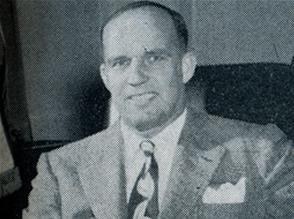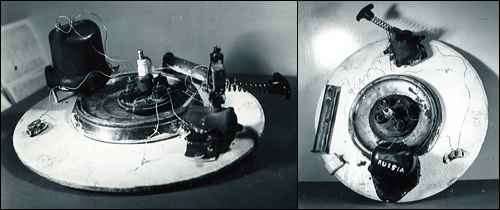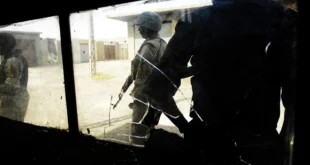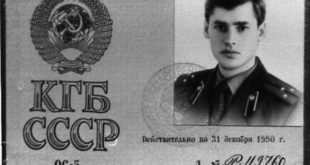
Uncover the Truth
It’s the most popular file in the FBI Vault—our high-tech electronic reading room housing various Bureau records released under the Freedom of Information Act. Over the past two years, this file has been viewed nearly a million times. Yet, it is only a single page, relaying an unconfirmed report that the FBI never even followed up on.
The file in question is a memo dated March 22, 1950—63 years ago last week. It was authored by Guy Hottel, then head of our field office in Washington, D.C. (see sidebar below for a brief biography). Like all memos to FBI Headquarters at that time, it was addressed to Director J. Edgar Hoover and recorded and indexed in FBI records.
The subject of the memo was anything but ordinary. It related a story told to one of our agents by a third party who said an Air Force investigator had reported that three “flying saucers” were recovered in New Mexico. The memo provided the following detail:
“They [the saucers] were described as being circular in shape with raised centers, approximately 50 feet in diameter. Each one was occupied by three bodies of human shape but only three feet tall, dressed in metallic cloth of a very fine texture. Each body was bandaged in a manner similar to the blackout suits used by speed fliers and test pilots.”
After relaying an informant’s claim that the saucers had been found because the government’s “high-powered radar” in the area had interfered with “the controlling mechanism of the saucers,” the memo ends simply by saying that “[n]o further evaluation was attempted” concerning the matter by the FBI agent.
That might have been the end of this particular story, just another informational dead end in the FBI files. But when we launched the Vault in April 2011, some media outlets noticed the Hottel memo and erroneously reported that the FBI had posted proof of a UFO crash at Roswell, New Mexico and the recovery of wreckage and alien corpses. The resulting stories went viral, and traffic to the new Vault soared.
So what’s the real story? A few facts to keep in mind:
First, the Hottel memo isn’t new. It was first released publicly in the late 1970s and had been posted on the FBI website for several years prior to the launch of the Vault.
Second, the Hottel memo is dated nearly three years after the infamous events in Roswell in July 1947. There is no reason to believe the two are connected. The FBI file on Roswell (another popular page) is posted elsewhere on the Vault.
Third, as noted in an earlier story, the FBI has only occasionally been involved in investigating reports of UFOs and extraterrestrials. For a few years after the Roswell incident, Director Hoover did order his agents—at the request of the Air Force—to verify any UFO sightings. That practice ended in July 1950, four months after the Hottel memo, suggesting that our Washington Field Office didn’t think enough of that flying saucer story to look into it.
Finally, the Hottel memo does not prove the existence of UFOs; it is simply a second- or third-hand claim that we never investigated. Some people believe the memo repeats a hoax that was circulating at that time, but the Bureau’s files have no information to verify that theory.
Sorry, no smoking gun on UFOs. The mystery remains…

Transcript of the latest FBI Podcast
For the purposes of this episode, we often use the original, commonly known term unidentified flying objects (or UFOs) to refer to what are now called unidentified aerial phenomena (or UAPs). FBI
Monica Grover: Since 1947, concerned citizens have been alerting the FBI to a variety of strange objects they’ve spotted in the sky.
Flying discs. Saucers. Flapjacks.
On this episode of Inside the FBI, we sat down with the FBI’s historian to uncover the truth about some of our noteworthy cases involving unidentified flying objects, or UFOs.
I’m Monica Grover, and this is Inside the FBI.
On July 8, 1947, our Dallas Field Office sent the following message—marked urgent—to FBI Director J. Edgar Hoover and to the head of our Cincinnati Field Office:
Voice: Flying disc. Information concerning. Headquarters eighth Air Force telephonically advised this office that an object purporting to be a flying disc was recovered near Roswell, New Mexico, this date.
The disc is hexagonal in shape and was suspended from a balloon by cable, which balloon was approximately twenty feet in diameter. Further advised that the object found resembles a high-altitude weather balloon with a radar reflector, but that telephonic conversation between their office and Wright Field had not borne out this belief.
Disc and balloon being transported to Wright Field by special plane for examination.
Grover: The memo goes on, noting that there’s national interest in the case and that news outlets were pursuing stories about the disc.
Eventually, the U.S. Air Force, at that time part of the U.S. Army, determined that this flying object really was an aerial balloon, and the case was closed.
But Roswell was just the beginning of these types of sightings and the stories that formed around them.
Throughout 1947, the FBI continued to receive reports of flying objects. In one case, an individual even claimed they saw a large circular saw blade hit a lightning rod on top of a church.
Dr. Fox, the FBI’s historian, explains that after Roswell …
Dr. John Fox: … there were several other sightings of unexplained aerial phenomenon, as we call them today, or UFOs, and there was kind of a cottage industry that grew up around people being concerned about things they saw in the sky that they couldn’t explain.
Grover: As they do now, these reports made headlines. But it wasn’t immediately clear what agency should look into them—or what they should do about them.
The public likely reached out to the FBI knowing the agency’s history of investigating airline crashes and other aerial dangers.
But was a UFO sighting really a case for the FBI?
Hoover recognized that the Air Force had jurisdiction for these cases, but he still wanted his agents to investigate any discs spotted or recovered for their potential impact on FBI responsibilities.
Fox: Hoover’s concern was several-fold. You know, the FBI had responsibility, of course, for protecting, you know, U.S. technology and information, in part. You know, they shared that with others, but they were concerned about that.
The fact that these things were happening and were of serious public concern also was of issue to the FBI, because we really have very broad authority to investigate under federal criminal law.
And so, simply kind of keeping our eye open for that thing was something that we were supposed to do.
Grover: Hoover also asked agents to help the Air Force by investigating these sightings to determine if they were legitimate, imaginary, or pranks.
Fox: In the early days of the Cold War, the Air Force was actually asking, at least for a couple of years, for the government agencies to report to them any UFO-related sightings and information they got because they were trying to compile it.
Grover: One of these reports the Bureau took down is documented in what’s known as the Guy Hottel memo. Named after the head of our Washington Field Office at the time, it’s a single page dated March 22, 1950.
Fox: The Guy Hottel memo says that we had someone who, you know, claimed to be an Air Force investigator who came in and said that, you know, he knew that, you know, these things had crashed.
Grover: The informant who came to the FBI said that some flying saucers had been recovered in New Mexico—along with human-shaped bodies that were 3-feet tall.
The FBI concluded that this was an unsubstantiated claim and determined that no investigation was necessary.
Nonetheless, the Guy Hottel memo gained notoriety in later years, after it was released publicly in the 1970s.
Fox: The Guy Hottel memo kinda became famous, in part, because someone did a news story on it saying, “Hey, the FBI has evidence of UFOs and little green men” or whatever. You know, it was something like, you know, it was a newspaper story, I believe. It’s kind of been recycled every few years, when someone new stumbles across it.
Grover: Because the memo mentions flying saucers in New Mexico, some people think it’s tied to the Roswell sighting. But Dr. Fox says there’s no reason to believe there’s any connection between the two, especially considering they’re dated almost three years apart.
Fox: What the Hottel memo simply reports is someone came in, told one of our agents this stuff, you know, we’ll see what happens.
Grover: By the early 1950s, Hoover changed the Bureau’s policy for investigating flying saucer reports, asking staff to now refer these matters directly to the U.S. Air Force. By that time, the Air Force had established a formal program related to these unexplained aerial phenomena.
Fox: They had a couple of different studies going on over the years, and they started with Project Sign, then Project Grudge, and then finally Project Blue Book, which was opened up in the early 50s to study these unexplained aerial phenomenon.
And so, at least from 1947 to the start of Project Blue Book, they wanted the other agencies to report to them when they had these kinds of sightings, so they could keep track of them. Once they kinda got that formal program going, the FBI backs off at that point.
Grover: After the Air Force took over these investigations, the FBI’s involvement in anything related to UFOs dropped off dramatically.
But in 1988, two of our field offices received reports about a government document—one classified under the codename “Majestic 12.” So, while cases of flying saucers in the sky weren’t assigned to the FBI anymore, the leak of a classified document definitely was.
Fox: It reported to be a summary of a government meeting about the disposition of the Roswell evidence and bodies.
The 12 members were putting together this plot to cover everything up, basically, and this is what this document was reputed to be. And the FBI, because, of course, we’re responsible for leaks of classified information, had received a copy of it and basically did some due diligence to see whether or not, well, is this actually a classified document?
Grover: We investigated the document and, as Dr. Fox explains, learned pretty quickly that it was a fake.
Fox: Of course, it doesn’t look right, it doesn’t really look like a lot of classified documents. And in checking with the Air Force, they of course said, “No, this is not, you know, an Air Force document,” and so forth. And there were other problems with the document itself.
Grover: These days, besides something like the leak of a classified document, there aren’t many reasons the FBI would get involved in matters related to UFO sightings.
And yet, for the almost 75 years since the Roswell crash, interest in UFOs and the FBI’s connections to these sightings have remained steady.
Dr. Fox explains that looking back at the 1940s and 50s, you can connect the dots between these flying saucer reports and the sociopolitical climate.
Fox: You have to remember, you know, 1947’s right after the end of World War II. During World War II, there was a lot of technological advancement in jet engines and in rocket engines.
And, of course, with the end of World War II, we had the start of the Cold War. And so, the conflict with the Soviet Union, and people were concerned about Soviet advancements, and what were they doing, and so forth.
But obviously, the U.S. government was certainly testing new aircraft, and new, you know, missiles, and that sort of thing. Likewise, the Soviet Union was. And there was a real race to see, among other things, who could get into space first.
So you know, there was that whole space race, and of course, the emergence of science fiction as a movie theme, and so forth, coming out a few years later, but it all ties into each other.
Grover: So what is it that’s carried this fascination into the 21st century?
According to Dr. Fox, a lot of it is just our human nature.
Fox: It’s kinda part and parcel of who we are. We’re a curious group—you know, both the FBI and the American people—and, you know, these things interest us.
In part, it’s based on incomplete information, it’s based on, you know, tenuous sightings and human memory, and all these things that are somewhat fallible. And so, it leaves a lot of holes, and, it’s in our genetics, in a sense, to fill those holes in, and to make them connect and make it all make sense.
And sometimes, we come up with some bizarre things, and sometimes, we end up just kinda throwing up our hands and saying, “Well, we don’t know.”
Ultimately, we can explain a lot of these things, but there are some things we just don’t know.
Grover: Of course, we couldn’t let Dr. Fox go without asking him one last question.
What does he think about UFOs?
Fox: Ultimately, I think they’re probably all explainable. I’m more than happy to think that there could be intelligent life somewhere else in the universe, but given physics, I don’t think we’re going to see it anytime soon.
Grover: But at the end of the day, he says:
Fox: Well, like Fox Mulder, I want to know.
Grover: And honestly, don’t we all?
This has been another production of Inside the FBI. You can follow us on your favorite podcast player, including Spotify, Apple Podcasts, or Google Podcasts. You can also subscribe to get email alerts for new episodes of our show at fbi.gov/podcasts.
I’m Monica Grover from the FBI’s Office of Public Affairs. Thanks again for tuning in.
 Soldier of Fortune Magazine The Journal of Professional Adventurers
Soldier of Fortune Magazine The Journal of Professional Adventurers






